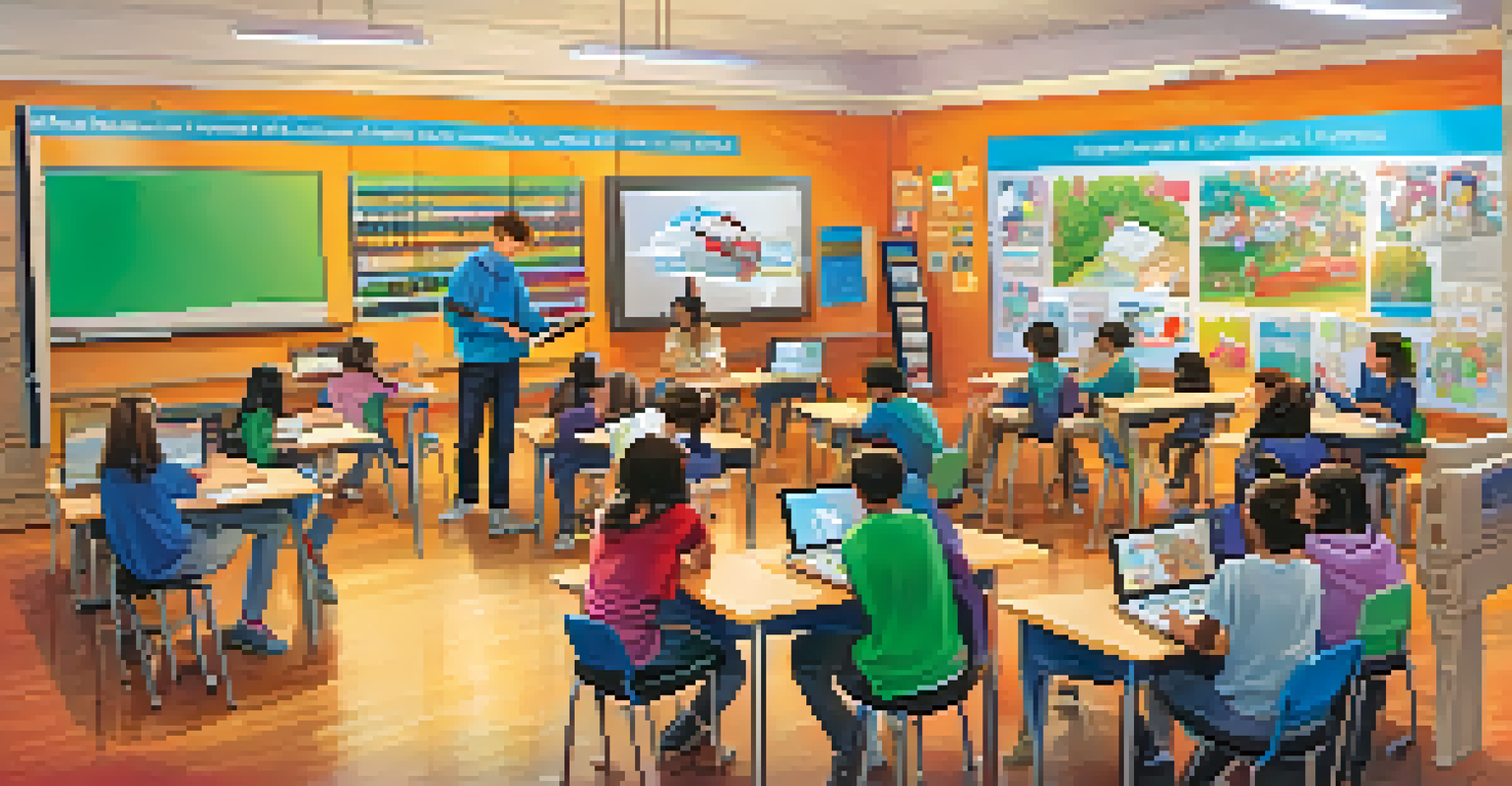Exploring the Effects of Screen Time on Learning Outcomes

Understanding Screen Time and Its Types
Screen time generally refers to the time spent using devices like computers, tablets, and smartphones. It can be categorized into different types, such as recreational use (like gaming and social media) and educational use (like online classes and research). Understanding these distinctions is essential, as not all screen time is created equal. For instance, educational screen time might enhance learning, while excessive recreational use could detract from it.
Technology is best when it brings people together.
With the rise of digital learning tools, screen time is increasingly associated with education. However, not every moment spent in front of a screen contributes positively to learning outcomes. If students are using devices for distractions or passive consumption, the benefits of educational content can be overshadowed. Therefore, it's crucial to analyze how different types of screen time influence students' academic performance.
Ultimately, distinguishing between productive and non-productive screen time helps educators and parents make informed decisions about technology use. Being mindful of how long and in what capacity students engage with screens can play a pivotal role in shaping effective learning environments.
Positive Effects of Screen Time on Learning
When used purposefully, screen time can offer significant benefits for learners. Educational apps and online resources can make complex subjects more engaging and accessible. For instance, interactive simulations in science or math can help students visualize concepts that would otherwise be abstract, enhancing comprehension.

Additionally, screen time can facilitate personalized learning experiences. Many educational platforms adapt to individual learning speeds and styles, allowing students to grasp concepts at their own pace. This tailored approach can be especially beneficial for those who may struggle in traditional classroom settings.
Screen Time: Productive vs. Distractive
Understanding the difference between educational and recreational screen time is crucial for optimizing learning outcomes.
Moreover, technology fosters collaboration among students. Online discussion forums and group projects encourage peer interaction, which can deepen understanding and retention of material. Thus, when integrated thoughtfully, screen time can amplify learning outcomes and engagement.
Negative Impacts of Excessive Screen Time
On the flip side, excessive screen time can lead to several negative consequences for learners. A major concern is the impact on attention spans; prolonged exposure to fast-paced digital content can make it difficult for students to focus on slower-paced, traditional learning activities. This can lead to a detrimental cycle where students struggle to engage in classes due to their accustomed high stimulation from screens.
The more we use technology, the more we need to manage it effectively to ensure it does not take over our lives.
Additionally, too much screen time can impact physical health, which in turn affects learning. Issues like eye strain, poor posture, and lack of physical activity are common among excessive screen users. These factors contribute to fatigue and discomfort, which can hinder a student’s ability to concentrate and absorb information.
Lastly, social skills can suffer when students spend more time in front of screens than interacting face-to-face. Effective communication and interpersonal skills are crucial for academic and personal success. Therefore, striking a balance between screen time and real-world interactions is vital for holistic development.
The Role of Parents and Educators
Parents and educators play a crucial role in managing screen time among students. Setting clear guidelines about how long and what types of screen time are acceptable is essential. For instance, establishing 'tech-free' times during meals or before bedtime can help create boundaries that promote healthier habits.
Moreover, involving children in discussions about screen use can foster a sense of responsibility. Encouraging them to reflect on their screen time choices can make them more mindful of how technology affects their learning and well-being. This collaborative approach can lead to better outcomes than simply imposing restrictions.
Excessive Screen Time Consequences
Spending too much time on screens can negatively affect attention spans, physical health, and social skills.
Educators also have a part to play by integrating technology effectively into the curriculum. Providing students with structured opportunities to engage with educational content while limiting recreational use during class time can create a balanced approach that maximizes benefits while minimizing distractions.
Finding the Right Balance
Finding the right balance between screen time and other activities is crucial for optimal learning outcomes. Experts suggest that setting specific time limits for recreational screen use can help students manage their time more effectively. For example, allocating certain hours for homework and study, followed by designated time for gaming or social media, ensures that educational priorities are met.
Incorporating breaks during screen use is another effective strategy. The Pomodoro Technique, which encourages short bursts of focused work followed by breaks, can help maintain concentration and reduce fatigue. This method allows students to recharge, which ultimately leads to better retention of information and improved learning outcomes.
Ultimately, encouraging a varied routine that includes physical activities, hobbies, and face-to-face interactions alongside screen time can create a well-rounded learning experience. By fostering a balance, learners are more likely to thrive academically and socially in an increasingly digital world.
Technological Tools for Monitoring Screen Time
With the rise of digital learning, various tools are available to help monitor and manage screen time effectively. Applications like RescueTime and Screen Time offer insights into how much time users spend on different types of activities. These tools can help students and parents identify patterns and make adjustments as needed.
In addition to monitoring, many devices come equipped with built-in settings that allow users to set time limits for specific applications or screen time overall. Leveraging these features can empower students to take charge of their screen usage and prioritize educational activities.
Balancing Screen Time and Learning
Finding the right balance between screen time and other activities is essential for fostering both academic and personal growth.
Using technology to regulate technology might seem counterintuitive, but it can be an effective way to ensure that students engage with screens mindfully. By utilizing these tools, families can foster healthier habits that support learning while still enjoying the benefits of technology.
Looking Ahead: The Future of Learning and Screen Time
As we move forward, the relationship between screen time and learning will continue to evolve. With advancements in technology, we can expect to see even more innovative educational tools that leverage screens to enhance learning experiences. Virtual reality classrooms and interactive learning platforms may become commonplace, offering immersive ways for students to engage with content.
However, as technology continues to develop, so will the need for guidelines and best practices. Educators and parents must remain vigilant in adapting to these changes and ensuring that screen time is beneficial rather than detrimental. Ongoing research will be vital in understanding how emerging technologies impact learning outcomes.

In conclusion, striking a balance in screen time will be essential for future generations. Embracing technology while maintaining a focus on holistic education can lead to a more enriching learning environment that prepares students for a successful future.